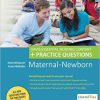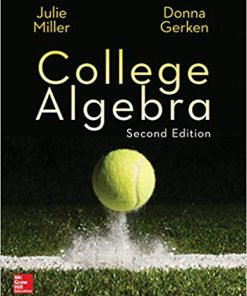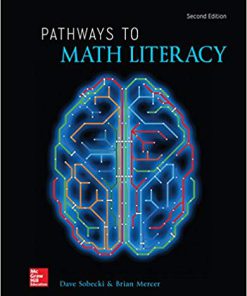(eBook PDF) Math Lit 2nd Edition by Kathleen Almy
$50.00 Original price was: $50.00.$35.00Current price is: $35.00.
(eBook PDF) Math Lit 2nd Edition by Kathleen Almy – Instant Download
(eBook PDF) Math Lit 2nd Edition by Kathleen Almy – Digital Ebook – Instant Delivery Download

Product details:
- ISBN-10 : 0134433114
- ISBN-13 : 978-0134433110
- Author: Kathleen Almy
Math Lit, by Kathleen Almy and Heather Foes, offers an accelerated pathway through developmental math, allowing non-STEM students to move directly into liberal arts math or introductory statistics. Through its emphasis on contextual problem solving, the Almy/Foes text and its accompanying MyMathLab® course help students gain the mathematical maturity necessary to be successful in a college-level non-STEM math class. Students work through carefully designed explorations, activities, and instruction to garner a greater conceptual understanding of the major themes of numeracy, proportional reasoning, algebraic reasoning, and functions. Enhancements in the Second Edition have increased the versatility and ease of use for students and instructors alike.
Table contents:
CYCLE ONE Where do we start?
Self-Assessment: Preview
1.1 The BP Oil Spill: Focus Problem
1.2 Getting Started: Reviewing Prealgebra
- Use Venn diagrams
- Write equivalent fractions
- Add, subtract, multiply, and divide fractions
- Solve applied problems involving fractions
1.3 Hello, My Name Is: Graphing Points
- Plot ordered pairs
- Determine the coordinates of a point
1.4 A Tale of Two Numbers: Ratios and Proportions
- Interpret ratios
- Scale ratios to produce equivalent ratios
- Determine if quantities are proportional
Getting Ready for Section 1.5
1.5 Chances Are: Probability Basics
- Find relative frequencies
- Find and interpret experimental probabilities
1.6 It’s All Relative: Understanding Integers
- Interpret signed number situations
- Find the opposite and absolute value of a number
1.7 Sign and Size: Integer Operations
- Add, subtract, multiply, and divide signed numbers
- Solve applied problems that involve signed-number addition, subtraction, multiplication, and division
1.8 An Ounce of Prevention: Means
- Find and interpret the mean of a set of numbers
- Use means in applied problems
Mid-cycle recap
1.9 Picture This: Making and Interpreting Graphs
- Create and interpret pie graphs
- Create and interpret bar graphs
- Create and interpret line graphs
1.10 Two by Two: Scatterplots 79
- Create and interpret scatterplots
- Sketch a curve to best fit a scatterplot
Getting Ready for Section 1.11
1.11 Multiply vs. Divide: Converting Units
- Convert units by multiplying or dividing
1.12 Up and Down: Percent Change
- Apply a percent change
- Find percent change
- Interpret percent change
1.13 The X Factor: Algebraic Terminology
- Differentiate between variables and constants
- Differentiate between expressions and equations
- Differentiate between factors and terms
1.14 General Number: Recognizing Patterns
- Make conjectures and generalize patterns
- Identify and use arithmetic and geometric sequences
1.15 Social Network: Linear and Exponential Change
- Model change with linear and exponential functions
1.16 Infinity and Beyond: Perimeter and Area
- Calculate perimeter and area
Cycle 1 Study Sheet
Self-Assessment: Review
Cycle 1 Wrap-Up
CYCLE TWO How does that work?
Self-Assessment: Preview
2.1 Predicting a Child’s Height: Focus Problem
Getting Ready for Section 2.2
2.2 Rule of Thumb: Weighted Means
- Find and interpret weighted means
- Find the median and mode of a data set
2.3 Measure Up: Basic Exponent Rules
- Apply basic exponent rules
- Use geometric formulas
2.4 Count Up: Adding Polynomials
- Identify and add like terms
2.5 A Winning Formula: Applying Order of Operations
- Use the order of operations to simplify expressions
- Evaluate formulas and expressions
2.6 Does Order Matter: Rewriting Expressions
- Apply the commutative and associative properties
2.7 Fair Share: Distributive Property
- Apply the distributive property to expressions
- Use the distributive property in applied contexts
2.8 Seat Yourself: Equivalent Expressions
- Write an expression to represent a scenario
- Determine if two expressions are equivalent by using the commutative, associative, and distributive properties
2.9 Parts of Speech: Using Operations Correctly
- Distinguish between an operator and an object
- Determine the object on which an operator is acting
- Recognize when the distributive property can be applied
Mid-cycle recap
2.10 A Fine Balance: Verifying Solutions
- Verify a solution to an equation
2.11 Separate but Equal: Solving Simple Equations
- Write and solve one-step equations
2.12 A State of Equality: More Equation Solving
- Solve two-step and multi-step linear equations
2.13 Quarter Wing Night: Writing and Solving Equations
- Write an equation to model a situation
- Solve a problem numerically and algebraically
2.14 Outwit and Outlast: Using Proportions
- Write and solve proportions
2.15 Three of a Kind: Pythagorean Theorem
- Use the Pythagorean theorem to find the length of a side in a right triangle
- Solve problems using the Pythagorean theorem
Getting Ready for Section 2.16
2.16 What Are the Odds?: Theoretical Probability
- Calculate theoretical probabilities
- Compare theoretical and experimental probabilities
2.17 Size Up: Volume and Surface Area
- Calculate volume and surface area
Cycle 2 Study Sheet
Self-Assessment: Review
Cycle 2 Wrap-Up
CYCLE THREE When Is It Worth It?
Self-Assessment: Preview
3.1 Deciding to Run: Focus Problem
3.2 What’s Trending: Correlation
- Determine if data has a positive or negative linear correlation
- Graph the equation of the trendline
- Use the equation of the trendline to make predictions
3.3 Constant Change: Slope
- Find the slope of a line from points, tables, and graphs
- Interpret the slope as a rate of change
3.4 Shortest Path: Distance Formula
- Use the distance formula to find the distance between two points
3.58 More or Less: Linear Relationships
- Make comparisons using equations, tables, and graphs
3.6 Get in Line: Slope-Intercept Form
- Find and interpret the slope and y-intercept from a linear equation
- Graph a line using a table and using the slope and y-intercept
3.7 Chain, Chain, Chain: Writing Linear Equations
- Write the equation of a line using a point and the slope
- Write the equation of a line using two points
- Create a linear model in an applied problem
Getting Ready for Section 3.8
3.8 Going Viral: Exponential Functions
- Write the equation of an exponential function using a starting value and rate of change
- Model with exponential functions
- Graph exponential functions
Mid-cycle recap
CYCLE Three When Is It Worth It?
3.9 Untangling the Knot: Solving Nonlinear Equations
- Solve nonlinear equations
Getting Ready for Section 3.10
3.10 Hot and Cold: Rewriting Formulas
- Solve an equation for a specified variable
3.11 A Common Goal: Greatest Common Factors
- Factor an expression using the greatest common factor
3.12 Thinking Outside the Box: Factoring Quadratic Expressions
- Factor quadratic expressions
3.13 A Formula for Success: The Quadratic Formula
- Use the quadratic formula to solve equations
3.14 Systematic Thinking: Graphing and Substitution
- Solve a 2 * 2 linear system of equations by graphing
- Solve a 2 * 2 linear system of equations by substitution
3.15 Opposites Attract: Elimination
- Solve a 2 * 2 linear system of equations by elimination
3.16 The Turning Point: Quadratic Functions
- Identify a quadratic pattern in data
- Find the vertex of a parabola
Cycle 3 Study Sheet
Self-Assessment: Review
Cycle 3 Wrap-Up
CYCLE FOUR What Else Can We Do?
Self-Assessment: Preview
4.1 Measuring Temperature Variability: Focus Problem
4.2 A Matter of Change: Dimensional Analysis
- Convert units using dimensional analysis
Getting Ready for Section 4.3
4.3 Little Giants: Scientific and Engineering Notation
- Convert numbers between scientific and standard notation
- Convert numbers into and out of engineering notation
4.4 A Model Approach: Negative Exponents
- Use exponent rules to simplify expressions that have negative exponents
4.5 Variation on a Theme: Standard Deviation
- Find the standard deviation of a data set
- Interpret the standard deviation of a data set
4.6 An Order of Magnitude: Understanding Logarithmic Scales
- Interpret logarithmic scales
Mid-cycle recap
4.7 Straight to the Point: Direct Variation
- Identify direct variation from a graph, table, or equation
- Write models for direct variation problems
- Solve direct variation problems
Getting Ready for Section 4.8
4.8 Gas Up and Go: Inverse Variation
- Identify inverse variation from a table
- Write models for inverse variation problems
- Solve inverse variation problems
4.9 Ghost in the Machine: Function Notation
- Use function notation
- Find a function input or output given the other
4.10 What’s Your Function? Vertical Line Test, Domain, and Range
- Apply the vertical line test
- Find the domain and range from a graph
4.11 An Important Point: Vertex Form of a Quadratic Function
- Identify the vertex of a quadratic function
- Graph a quadratic function in vertex form
- Write the vertex form of a quadratic function
4.12 A Survey of Trig: Trigonometric Functions
- Write the six trigonometric ratios for an acute angle
- Use trigonometric functions to find the measures of sides and angles of a right triangle
Cycle 4 Study Sheet
Self-Assessment: Review
Cycle 4 Wrap-Up
Excel Appendix (online) EA-1
Answers (online) A-1
Index I-1
Applications Index
People also search:
math literature books for 2nd grade
introduction to mathematical literacy 2nd edition pdf
pathways to math literacy second edition answer key
pathways to math literacy second edition answer key pdf
math 2nd paper
You may also like…
Education Studies & Teaching - Higher & Further Education
500 GRE Math Questions to Know by Test Day, 2nd Edition Sandra Luna Mccune – eBook PDF
Biology and other natural sciences - Ecology
Fundamentals of Ecosystem Science 2nd Edition Kathleen C. Weathers – eBook PDF
Business & Economics - Others
Practical Business Math Procedures [with Business Math Handbook] – eBook PDF
Biology and Microbiology
(eBook PDF) Foundations in Microbiology 10th Edition by Kathleen Park Talaro





![Practical Business Math Procedures [with Business Math Handbook] - eBook PDF](https://ebooksecure.com/wp-content/uploads/2024/03/practical-business-math-procedures-with-business-math-handbook-10018148-247x296.jpg)





